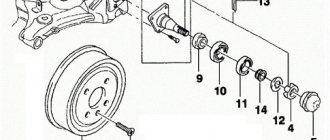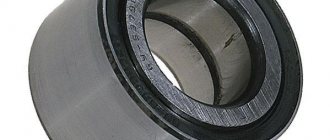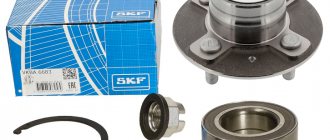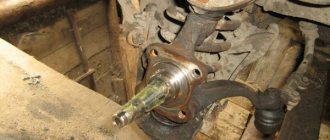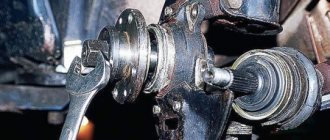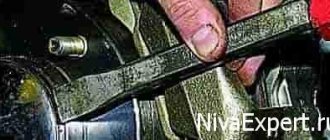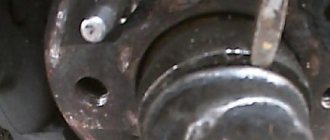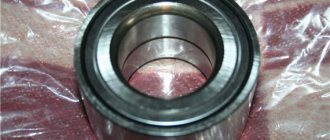After replacing the wheel bearing, an important moment comes - tightening. You need to lock it not with your “bare” hands, but with the help of a special device - a torque wrench. Since the service life of the equipment and the quality of control of technical means directly depend on the completeness of the tightening.
Each car has its own torque on the wheel bearings. This is clearly described in the operating instructions. If for any reason the manual is lost, you should use the Internet or contact your nearest auto repair shop for clarification.
How hard should you tighten the wheel nut on your car?
Torque standards are established for each car, since the tightening force for the locknut depends on the following factors:
- Bearing dimensions;
- Regulated axial clearance;
- Diameter and thread pitch.
The following are the force indicators for properly tightening the nut. The database will be gradually replenished.
Advice:
If you have not found the tightening torque values for your car (Skoda Octavia, Subaru models, Toyota Corolla), find the bearing you have installed and the same thread diameter or ask a question in the comments.
Adjusting Wheel Bearings
Home » Repair Tips » Adjusting Wheel Bearings
The bearings that are installed on car wheel hubs wear out over time. We will try to independently adjust these components and change products.
The bearing adjustment procedure involves the following stages:
- First, the car is placed on a level site, secured with a handbrake. At the same time, you can place anti-recoil devices.
- Then we lift the axle from behind using a jack.
- We remove the axle shaft of the car to clarify the rotation of the wheels. Having discovered difficulties, we find out the source of the disease. There may be “sticking” at the oil seal and contact at the brake pads.
- Next, unscrew the locknut and remove the stop washer. When we slightly unscrew the fastening nut on the bearing, we will re-check the rotation on the wheel. Adjustment procedures are permitted if the component moves easily.
- Let's use a torque wrench to tighten the nut. The force on the structure should not exceed 100 Nm (at the same time we turn the wheels). Then the rollers will be evenly placed on the bearings.
- Unscrew the nut again. To maintain the rotation angle, we make turns on the washer by a couple of positions and holes. We mount the stopper nut, controlling the entry of the pin into the slot.
- We tighten the locknut, maintaining a force of up to 200 Nm.
- When making adjustments, we control the free rotation of the wheel and the absence of axle play.
- We install the axle shaft with spring washers. We re-tighten our nuts to secure the studs.
- We lower the wheel until it touches the ground. We make a trip and test the equipment. Sometimes, when moving, the hub begins to heat up, reaching 700 degrees. Then the adjustment procedure will have to be repeated.
Now we try to pull out the hub on the rear wheel when we change the bearing.
We carry out the manipulations:
- Let's turn the flange by tightening the mounting bolts on the hub (in contact with the bracket). We act through the hole on the body part - we compare it with the bolts of the element.
- Then we remove the fasteners holding the mechanism.
We also advise you to read: Vote, did you like the article?
(2 votes, rating: 5.00 out of 5)
Tightening torques for the front wheel bearing on a VAZ (LADA)
| No. | Automobile model | Force, N•m | Hub nut diameter/thread size |
| 1 | VAZ 2101 - 2107, OKA | 196 – 199 | M18x1.5 |
| 2 | NIVA VAZ 21213 and 21214 | 196 – 199 | |
| 3 | Kalina, Granta, Priora, Largus, Vesta | 226–247 | M20x1.5 |
| 4 | VAZ 2108, VAZ 2109 - 2110, 2111 - 2115 | 226–247 |
ATTENTION:
Maintaining a clean operating environment is essential for proper operation and long service life of hub gears.
Be sure to clean the outside of the hub gearbox and adjacent parts to prevent dirt from entering the gearbox when removing it. Before assembling the gearbox, also clean all parts, both old and new.
All moving parts must be lubricated before assembly. Be sure to use the lubricant recommended in group 0 of this technical manual.
Dismantling the hub under the heading "Refurbishment" is carried out in order. If, for example, you need to change the wheel bearings, skip the sections entitled "Replacing the Driven Gear Bearing" and "Replacing the ABS Pulsating Wheel."
The numbers after the names refer to the perspective drawing.
Tightening torques for the front wheel bearing on Ford
| No. | Automobile model | Force, N•m | Hub nut diameter/thread size |
| 1 | Focus 1 | 45 (further tighten another 90 degrees) | M18x1.5 |
| 2 | Focus 2 | ||
| 3 | Focus 3 | ||
| 4 | Mondeo | 35 (then tighten another 90 degrees) | |
| 5 | Fusion | 35 (then tighten another 90 degrees) | |
| 6 | Transit | 53 | M20x1.5 |
Refurbishment
Removing the axle shaft
Special tools
Support mechanisms
587 121 Wheel lift trolley
1 Place axle supports under the rear axle cardan.
2 Remove the wheels. Use a dolly to lift the wheels.
ATTENTION!
Never work under a vehicle that is supported only by a jack. Use axle stands. If the front axle has air suspension, the air reservoir must be deflated.
3 Rotate the hub so that the magnetic plugs 40
were strictly up or straight down.
ATTENTION!
The valve in the hub cap may be clogged. Use safety glasses as oil may spray out under high pressure when the oil plug is removed.
4 Drain the oil from the hub by removing both magnetic plugs.
5 Remove any metal particles that have accumulated on the magnetic plugs.
6 Remove four bolts 34
, cover
14
and thrust washer
22
.
7 Screw one M10 bolt into the tip of the axle shaft and pull it towards you approximately 20 cm. If the axle shaft comes out completely, the internal seals are damaged.
8 Remove the retaining ring 33
.
9 Remove the thrust washer 27
, drive gear
17
, thrust washer
22
and retaining ring
28
.
10 Screw two M6 bolts into the protective coupling 99 286. These bolts will make it easier to remove the coupling later. The protective coupling protects the oil seal 23
from damage when the axle shaft is completely removed. Lubricate the coupling outside and inside.
11 Insert the protective sleeve over the axle shaft.
Do not press the clutch too tightly, so as not to damage the axle shaft, and, in addition, the clutch will be difficult to remove later. Note:
A safety coupling must be used to protect the seals
23
.
Tightening torques for the front wheel bearing on a Chevrolet
| No. | Automobile model | Force, N•m | Hub nut diameter/thread size |
| 1 | NIVA | 191 – 195 | M18x1.5 |
| 2 | Lanos | 184 - 204 (then weakens and tightens 15.3 - 18.4) | M20x1.5 |
| 3 | Aveo | ||
| 4 | Lacetti | 254–300 | |
| 5 | Cruz | 50, turn 40˚ | M20x1.5 |
Shoe brake front axle of Scania trucks
Technical description and repair manual
Exploded view…. ………………………………..…… 2
Repair manual ………. …………………………………….………. 4
Checking the wheel bearing clearance……………………………………..… 4
Replacement of wheel bearings……………………………………………..…. 5
Special devices and tools………. ……………………………………. 8
Tightening torques for the front wheel bearing for Renault
| No. | Automobile model | Force, N•m | Hub nut diameter/thread size |
| 1 | Logan | 175 | M20x1.5 |
| 2 | Megan 1, Megan 2 | 280 | |
| 3 | Sandero | ||
| 4 | Duster 4x4 | 280 | |
| 5 | Duster 4×2 | 175 |
FakeHeader
Comments 13
I tightened it with a torque wrench and set it to 200 n.m. According to the book from 190 to 210
On P2 they are adjustable and loosening is necessary so that the bearing has a slight play, which will disappear when it warms up during movement, otherwise it will “burn out” and jam, the service life will decrease quickly. And here I think about the tightening torque of the CV joint (you can look at the approximate tightening torque on other brands by analogy). And so, of course, you don’t have to pull to break off the CV joint or rip off the nut))), but you already have to be a jock or have a 3 meter wrench)).
On P2 it was written to tighten with a certain force and then unscrew by 10 or 20 degrees) but who knows, you need to read the book)
Tighten it as much as possible, it’s not scary.
the maximum can be different, but it’s probably still too much, it’s completely impossible, then there is a certain amount of force with which to tighten it.
On the second generation of sports it is not adjustable, if you have play that you can feel with your hands, then just change it. I changed it for myself, installed the original on one side of the hub assembly, and then slowly bought the original bearing, disassembled the old hub and pressed in a new bearing, and then changed the other side. By the way, the bearing is KOYO in the original, if that :). I bought the hub for 6300 rubles (maybe more expensive now), and the bearing was about 3 thousand.
View Queue
Queue
How to tighten the hub nut to the correct torque
To tighten threaded connections, where it is recommended to maintain a certain torque, use special torque wrenches . Inside the tool there is a dynamometer with a scale or a special device with a limiter, which is activated when the required tightening force is reached. Keys also come with value intervals, for example 5-25 (minimum 5 N•m, maximum 25 N•m).
The threaded connection is tightened until the arrow shows the required value or the limiter operates. There are also expensive and exact analogues - with an electronic display, but for the operation and repair of passenger cars a mechanical version is suitable.
The photo shows the main types of such keys.
- With preset torque, not adjustable.
- With preset torque value, adjustable.
- With tightening force indicator.
- With digital display of applied torque.
Watch the video on how to use a torque tool:
How to use the torque wrench scale:
How to use a torque wrench:
Adjustment
Checking its functionality and adjusting it is carried out as follows:
- Raise the front wheel using a jack;
- Remove the wheel;
- Using a chisel, remove the protective cap on the front hub bearing;
- Remove the brake pads;
- The indicator holder should be secured to the steering knuckle;
- Place the leg of this indicator against the hub, as close as possible to the adjusting nut;
- Rings of spanners are placed on the studs and the nuts are tightened. While holding them, the hub rotates and moves in the axial direction;
- Using the indicator, the movement or gap indicator is determined. If it is more than 0.15 millimeters, the gap must be adjusted;
- Reinstall the wheel without using the protective cap. Secure it with two bolts screwed in diametrically;
- Using a chisel, straighten the flange on the bearing nut and remove the nut with a 27mm (socket) wrench;
- Using a torque of 2.0 kg-cm, tighten the new adjusting nut;
- Loosen the nut, then tighten it again, but now with a torque of 0.7;
- Slowly release the adjusting nut 25 degrees and turn the wheel in a vertical plane. There should be a slight play;
- Check the gap. Its indicators should be in the range from 0.08 to 0.02 millimeters;
- In this position, lock the nut with the collar caulked in special grooves. They are located on the steering knuckle at the end of its axle;
- Remove old grease from the protective cap and apply new one. About 25 grams. Experts recommend using Litol 24, although there are worthy alternatives;
- Install the protective cap on the bearing;
- The wheel is installed in its rightful place.
Such diagnostics with repair elements will extend the life of your wheel bearing. If the adjustment does not allow the gap to return to the required parameters, the bearing should be completely replaced.
How to tighten a hub nut without a torque wrench
Many car enthusiasts, when repairing their car, consider it not advisable to purchase torque wrenches or other specialized devices (pullers, etc.). There is a good way to tighten the fastener to the required torque without using a torque gauge.
The following equipment will be required:
- Ratchet with a head for a lock nut;
- Pipe for extending the ratchet to create the required “shoulder”;
- Roulette;
- Marker;
- A load that can be hung on the “shoulder” (for example, a 32 kg weight).
The essence of the method is to calculate the moment using the formula from elementary physics classes:
M = P•l, where
P is the applied force, N; l is the distance from the hub to the point of application of force - the “shoulder”, m. The ready-made formula for our case will be as follows:
P1 = (M2•100)/(M1•10) (•10 (or •9.8) - translated into Newtons), where
P1 is the distance at which the sinker is attached to the “shoulder” relative to the torsion point, cm; M1—cargo mass, kg; M2—required torque, N•m.
Calculation example for a Ford Focus 2 car
P1 = (M2•100)/(M1•10) (•10 (or •9.8) = (45•100)/(32•10) = 4500/320 = 14 cm.
Conclusion: to ensure a tightening torque of 45 N•m, a sinker weighing 32 kg will be required, located on the pipe at a distance of 14 cm.
Sequencing:
- First screw on the locknut and tighten it slightly.
- We mark a distance of 14 cm, where the rod should hang;
- We hold the ratchet with one hand and hang the sinker with the other, thereby tightening the fastening;
- The operation continues until the fasteners stop tightening under weight, which means that we have achieved the required force. Accuracy +/- 5%.
Algorithm of actions
Place the Hyundai Solaris on a flat surface and place shoes under the wheels.
Raise the car using a jack and remove the wheel. Loosen the nuts only when the car is on the ground.
Take a 32mm wrench and use it to unscrew the hub nut, securing the brake disc with a flat screwdriver.
Remove the wheel rotation sensor.
Remove the brake disc.
Dismantle the tie rod ends and remove the ball joint.
Unscrew the steering knuckle from the post and remove the latter.
Typically, the inner ring remains and the bearing breaks. The ring is knocked off with a chisel.
Now you can remove the bearing ring using the same mounting blades
Using a screwdriver, pry up and pull out the retaining ring.
Use a puller to press out the bearing.
When starting to replace a part, the seating surface must be properly prepared by cleaning it. After cleaning, apply engine oil or the previously mentioned liquid.
A new bearing is installed in the fist. Press it in with a puller and install the locking element.
The last step is to install the steering knuckle in place. All that remains is to tighten everything correctly so that the car drives quietly and gives true comfort to the driver.
According to the instruction manual, the tightening torque of the front wheel bearing should be 88.3 - 107.9 Nm. This is official information provided by the manufacturer, and therefore you should not improvise, since a lot depends on the effort applied. We can conclude that the procedure is not simple, but there is nothing supernatural in it, and therefore you will even be able to save your own money.
The front wheel bearing torque is the force with which the hub nut is tightened. Units of measurement – N*M (or kgf*m). The front bearings have internal axial clearance, which is necessary for proper operation of the bearing, namely:
- preventing angular displacement of rings;
- reduction of friction of rolling elements and raceways;
- correct distribution of internal stresses on separators and cages.
- compensation of thermal expansion.
- increasing the contact angle for axial loads.
In turn, the axial internal clearance of a double-row ball bearing is the amount by which the inner rings move relative to the outer one. In order for the axial clearance to be within the tolerance, the ball bearing (or roller) is adjusted, this is done by correctly tightening the hub nut.
Familiarize yourself with the mounting and arrangement of the bearing with the front hub, as well as with the design of the wheel ball bearing.
The video also shows the process of adjusting the backlash by the locknut tension level:
Are you here
By correctly determining with what force to tighten the hub nut and stopping in time, you can avoid stripping the threads and the need to perform expensive repairs, taking into account today's prices for nuts. Craftsmen perform this work using a special torque wrench. Since a wheel bearing is a rather capricious product and additional equipment is not always at hand, it is very important to know the answer to this question.
Before work, it doesn’t hurt to determine what type of it is installed, for example, it can be conical or roller.
Assembly
– that’s it, we begin the process of assembling the rear hub bearing on the VAZ 2109, 2110. To do this, we put the hub on the axle (by removing the bolt with which we tightened the cages);
– tighten and tighten the central nut (be sure to install a new one), not forgetting to put the thrust washer;
– put on and screw on the brake drum and wheel;
– check the rotation (there should be no extraneous noise);
– if all is well, lower the car from the jack;
– tighten the wheel and the central nut (the tightening torque of the hub is approximately 20 kgm, this is quite a strong tightening, if you don’t have a torque wrench, you need to use a lever of at least a meter to tighten the nut with a force twice the tightening force of the wheels);
– tighten the hub nut and tighten the wheels.
Video text
HOW TO CORRECTLY TIGHTEN THE HUB NUT OF VAZ 2109, 2114, 2110, 2112? VAZ hub nut tightening torque
Front wheel hub mounting nut Thread M20x1.5
Tightening torque, N•m (kgf•m) 225.0–250.0 (22.5–25.0)
Rear wheel hub bearing nut Thread M20x1.5
Tightening torque, N•m (kgf•m) 190.0–225.0 (19.0–22.5)
Or when dismantling the gearbox, many drivers have to unscrew and tighten the hub nut
wheels. But this is not as simple as it seems from the outside, and the nut must be tightened to a certain torque, otherwise there is a risk of the bearing turning on the hub and subsequent . In addition, most of the keys sold in stores are not designed for the high tightening torque that the hub nut requires. In this short article we will look at the importance of this seemingly simple operation, and how to do it without a torque wrench.
In the 80s of the last century, tapered roller bearings were finally abandoned, and even on our domestic cars (front-wheel drive) double-row ball (or roller) bearings (or single-row with a thrust shoulder) began to be installed. And finally, there is no need for precise adjustment of tapered bearings, in which for many, adjusting the required clearance was not an easy task.
Indeed, in modern non-tapered bearings, the axial clearance is set by the bearing manufacturer (read about bearings and their markings) and no adjustments are required when assembling the unit. But many people do not attach importance to the correct tightening of such bearings, or rather the hub nuts, but in vain.
1 - halves of the inner race of the bearing, 2 - outer race of the bearing, 3 - balls, 4 - bearing cage, 5 - CV joint tip (trunnion), 6 - washer, 7 - nut.
For example, let’s take the hub unit, common on our front-wheel drive cars (VAZ 2108), with a double-row ball bearing (its marking is 6-256907E2S17), shown in the figure on the left. If you tighten the hub nut 7 on the thread of the end of the CV joint, then the halves of the inner race of the bearing will close completely and further convergence of the ball raceways will be impossible. And in this clamped state, the axial clearance in the bearing will be approximately 0.06 - 0.08 mm.
This means that hub nut 7 must hold the halves of the inner race of the bearing long enough (and provide the required clearance of 0.06 - 0.08 mm), that is, throughout the entire service life of the bearing. This means that the nut should not allow the distance between the halves of the cage to increase and the required clearance to be violated. And the more correct the tightening torque of this nut, prescribed by the factory, the longer the required clearance in the bearing will be ensured.
Hub nut - required tightening torques
The required tightening torque for the hub nut is prescribed not by the bearing manufacturer, but by the car manufacturer, and this torque differs slightly for different cars (for example, for a VAZ 2108, the torque is 225.6 - 247 N m, that is, 23 - 25 kgf m). Therefore, it is advisable to clarify it in the factory recommendation of your car.
